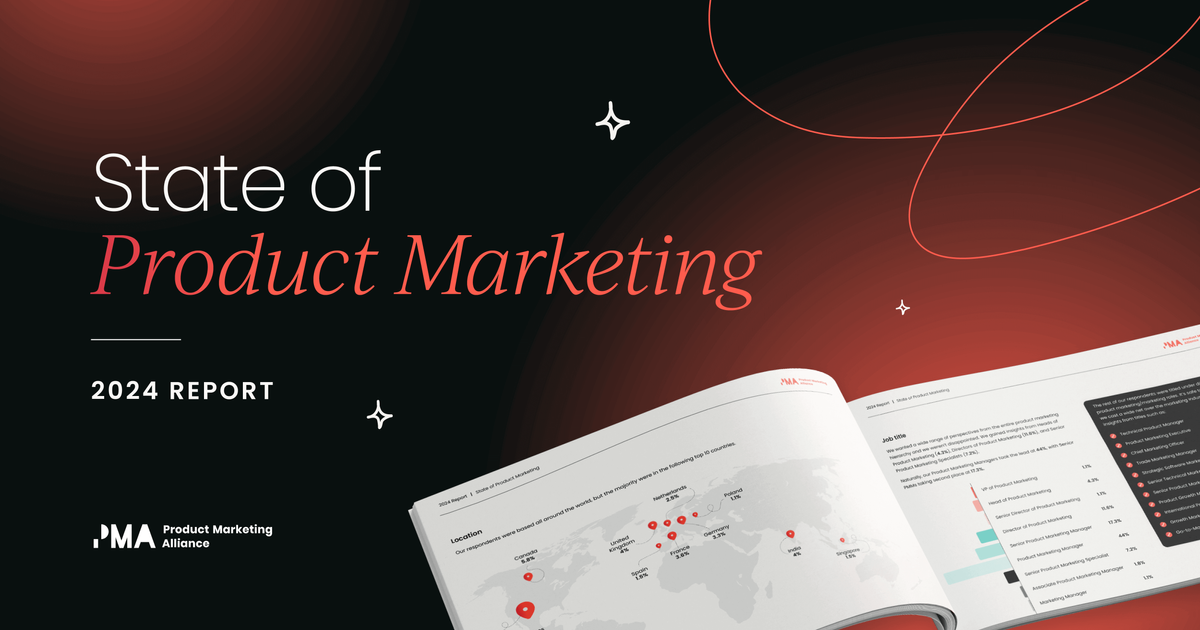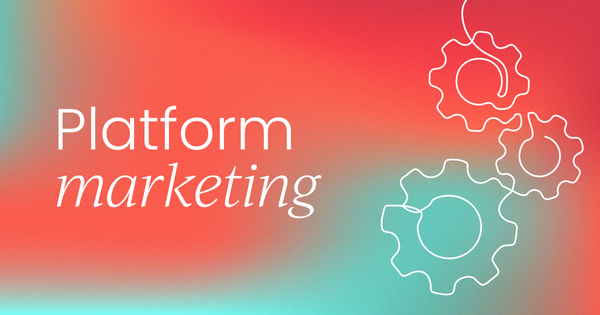TL;DR: Platform marketing is the strategy of using digital platforms, like social media, to promote a product or brand.
As of April 2024, Facebook had over 3 billion monthly active users, whereas TikTok surpassed YouTube as an influencer marketing platform in 2021, and is expected to continue rising to 54.9% of marketers using it in 2025. In addition, when you look at the top 10 largest companies in the world by market capitalization, five of them are platforms: Microsoft, Apple, Alphabet, Amazon, and Meta platforms, like Facebook.
These figures show one thing: the importance of platforms as a marketing tool.
Platforms allow you to reach your customers and engage them and are cost-effective because they tend to come with integrated tools for targeting, data analysis, and community-building.
So, here’s an in-depth look into what platform marketing is and why you shouldn’t dismiss it.
What is platform marketing?
Platform marketing means using platforms (social media, e-commerce sites, or apps) to promote a product. Once you find out where your customers are most active, you can then leverage the features of that platform to communicate with them and create tailored content.
Different platforms have different audience behaviors – TikTok is all about short videos while people love reading long-form articles on LinkedIn – so your marketing strategies need to reflect this.
Another thing to know is that platforms allow for a two-way street when it comes to transactions, meaning people can buy products from other users, not just from the business itself. For example, while Amazon reached nearly 575 billion U.S. dollars in net sales revenue worldwide in 2023, it doesn’t own most of the products it sells – it mainly provides the space for transactions between sellers and buyers.
“Two-sided networks can be found in many industries, sharing the space with traditional product and service offerings. However, two-sided networks differ from other offerings in a fundamental way. In the traditional value chain, value moves from left to right: To the left of the company is cost; to the right is revenue.
“In two-sided networks, cost and revenue are both to the left and the right, because the platform has a distinct group of users on each side. The platform incurs costs in serving both groups and can collect revenue from each, although one side is often subsidized, as we’ll see.” – Strategies for Two-Sided Markets, by Thomas Eisenmann, Geoffrey Parker, and Marshall W. Van Alstyne
Benefits of platform marketing
If you want to find out your audience’s demographics on YouTube – such as how old they are and where they’re from – all you have to do is log into your account, go to the analytics section, and get the data. Platforms provide tools that allow you to segment your audience and reach specific people based on their location, interests, etc. (a.k.a., targeted advertising).
Digital platforms also give you detailed analytics, making it easier to form decisions, measure engagement and conversions, check your ROI, and so much more, all in real time.
Another thing you get from platforms like YouTube or TikTok is diverse advertising formats, from display ads and influencer collaborations to video ads and sponsored posts – each suited to different goals, like brand awareness and lead gen.
Additionally, a lot of platforms already have large user bases you can use to reach a lot of people.
And it’s worth mentioning that platforms, especially social media, allow for two-way communication between you and your customers, which leads to higher engagement, stronger relationships, and loyalty.
What are the challenges of platform marketing?
Platform businesses need to attract both buyers and sellers at the same time, which is often called the chicken-and-egg problem. For example, Uber had to get enough drivers to attract riders and vice-versa.
Building trust is crucial but challenging, especially in two-sided businesses. For instance, people trust a company like Airbnb because of reviews, vetting processes, and dispute resolution systems. Without these things, people would be reluctant to use them.
Sometimes, people may try to complete transactions outside of a platform to avoid fees, which is known as platform leakage. This not only cuts down your revenue, but also reduces trust levels, since transactions outside the platform don’t have the same protection mechanisms.
Other challenges include fragmented audience data across different platforms, which makes it harder to target and measure the success of a campaign. To overcome this, you can use data integration tools to cobble together information from multiple sources.
Types of platforms (and how to use them)
Social media platforms
Overall, social media platforms let you manage and optimize social media campaigns, as well as build your brand by creating great content that resonates with your audience.
By responding to comments, messages, and feedback promptly, you’re also increasing customer satisfaction and loyalty – and building a community around your product/service.
Examples: Facebook, Instagram, LinkedIn, TikTok.
Email marketing platforms
Email marketing platforms allow you to automate and manage your emails, newsletters (a great way to deliver valuable content and keep your audience engaged and informed), and drip campaigns.
Best practices include segmenting your audience by behavior and location, which allows you to send more targeted messages.
Automation makes your job 1,000x easier – you can set up automated sequences for new subscribers or for people who’ve abandoned their cart, which can prompt them into buying something.
Examples: Mailchimp, ActiveCampaign, Sendinblue.
Content marketing platforms
With these tools, you can create, publish, organize, and optimize your content, from articles to videos and tutorials.
Consistency is key, so make sure you’re posting content on a regular basis to build credibility and keep the attention of your audience.
Examples: HubSpot, Contently, CoSchedule.
Affiliate and influencer marketing platforms
With these platforms, you can leverage affiliate partnerships and/or influencer collabs to promote your products and services.
Remember, when setting up an affiliate program, it’s important to define the commission structure (e.g., percentage per sale or a fixed amount) and provide unique tracking links for people to use.
Partner with bloggers, content creators, or websites that you see are helpful to promote your product. In addition, why not offer affiliates things like discount codes, which can help strengthen your relationships with them?
Examples: ShareASale, CJ Affiliate, Impact, Traackr, Influencity.
Advertising platforms
Advertising platforms, from programmatic to display and PPC (pay-per-click), allow you to buy and manage online ads, which drive traffic to your site, boost your visibility, and generate leads/sales.
Popular platforms include:
- Google Ads: They’re great for intent-driven search advertising, as well as display ads.
- Meta Ads: Ideal for social media advertising targeting specific demographics and interests.
- LinkedIn Ads: Great for B2B and for targeting professionals across many industries and markets.
- TikTok Ads: If you want short-form video campaigns aimed at younger audiences, then TikTok might be what you’re looking for.
To make the most of these platforms, you’ll want to define your target audience, design ads that grab people’s attention with nice visuals and calls-to-action, A/B test to see which version of the ad performs better, and consider retargeting as well – this re-engages people who’ve visited your site before but didn’t convert.
Examples: Google Display Network, Microsoft Advertising, Taboola, AdRoll.
Marketing automation platforms
With marketing automation platforms, you can automate repetitive tasks like emails, social media posts, and segmentation – as they let you segment your data and target customers depending on their demographics, purchasing behavior, etc.
These platforms help you nurture your leads as well, since you can set up automated email sequences for different stages of the customer journey (e.g., welcome and follow-up emails).
And drip campaigns are easier because you can create automated workflows based on people’s actions, like abandoning a cart or browsing a product.
Example: HubSpot, Marketo, Active Campaign, Pardot.
E-commerce marketing platforms
With these platforms, you can run marketing campaigns for your e-commerce business, including email, notifications, and ads.
Also make sure you encourage satisfied customers to leave reviews – social proof can make or break a purchase. For instance, 87% of buying decisions start with online research and the average consumer reads ten reviews before deciding to buy.
Optimizing your listings is crucial to make the most of this, so use high-quality images, descriptive copy, and keywords to improve searchability.
Promote related products to upsell and cross-sell (a.k.a., increase the value of your average order), and also offer discounts and promotions to attract new business and retain customers.
Example: Amazon, Shopify, Klaviyo, Yotpo.
Mobile marketing platforms
Mobile marketing platforms allow you to send timely, relevant notifications to app users to boost engagement, send targeted SMS messages promoting offers and launches, and leverage geofencing to send push notifications when a customer is at a specific location (such as your store).
For instance, a retail app can send notifications to alert customers when their favorite items are back in stock, to encourage repeat purchases.
Example: AppsFlyer, Leanplum, Airship, MoEngage.
In short
Platform marketing is now an essential strategy for businesses. It’s all about using platforms to promote a product or service, from social media to email and content – and beyond.
Being successful with platforms requires understanding them in-depth, as well as adapting to customer behaviors and tweaking strategies as needed to stay ahead of the competition.
Have you downloaded your free copy of the State of Product Marketing Report? Get ideas on how to maximize your resources (including your budget), uncover team dynamics, and so much more.



















 Follow us on LinkedIn
Follow us on LinkedIn




.svg?v=1abcb94374)